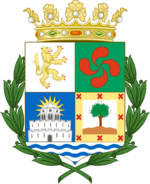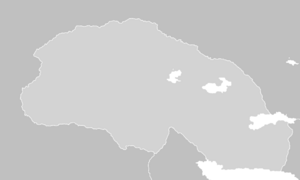Ibarmentudia
This article is incomplete because it is pending further input from participants, or it is a work-in-progress by one author. Please comment on this article's talk page to share your input, comments and questions. Note: To contribute to this article, you may need to seek help from the author(s) of this page. |
National Kingdom of Ibarmentudia Ibarmentudiako Erresuma Nazionala | |
|---|---|
| Motto: "Nire herrialdea, Nire arbasoak, Nire erregea" "Country of me, my ancestors, and my king" | |
| Anthem: One unending glory Ibarmentudiak: Amaigabeko loria bat | |
Location of Ibarmentudia (dark grey) in Parthenia (dark green) | |
| Capital | Aranarteamendia |
| Largest city | Alboziradia |
| National language | Ibarmentudiak |
| Ethnic groups |
|
| Demonym(s) | Ibarmentudiak |
| Government | Confederal Constitutional Monarchy |
• Errege | Trajano II |
• Lehendakari | Sofokles Aragor |
| Legislature | Legebiltzarra |
| Establishment | |
• Grand Duchy of Alboziradia | 739 |
• House of Aguirregoitiafelipena | 1204 |
• Kingdom of Ibarmentudia | 1649 |
• Federal Republic of Ibarmentudia | 1821 |
• House of Saenz | 1857 |
• Constitutional Constitution | 1864 |
| Area | |
• Total | 538,853.61 km2 (208,052.54 sq mi) (TBD) |
| Population | |
• 2022 estimate | 21,390,000 |
• 2015 census | 21,831,820 |
• Density | 39.7/km2 (102.8/sq mi) |
| GDP (PPP) | 2020 estimate |
• Total | $213,2 Billion |
• Per capita | $9967.89 |
| GDP (nominal) | 2020 estimate |
• Total | $305.2 billion |
• Per capita | $14,270.45 |
| Gini (2021) | medium |
| HDI (2021) | very high |
| Currency | Txanege (ITX) |
| Date format | dd-mm-yyyy |
| Driving side | right |
| Calling code | +74 |
| ISO 3166 code | IBM |
| Internet TLD | .ik |
Ibarmentudia, officially the National Kingdom of Ibarmentudia (Ibarmentudiak: Ibarmentudiako Erresuma Nazionala) is a federal constitutional kingdom located in central Parthenia, bordered by the Goimendi mountains to the west, Almagria and the Itsandia strait to the south and Telekia to the south-east, and covers a surface area of 538,853.61 km². Ibarmentudia consists of four Confederal States: Handikogoiordoki, Edurnebaso, Aintzirubeheanibai, and Zurihaitzkostaldea, which are further subdivided into Confederal Provinces. Ibarmentudia has a population of 21.4 million, which has been in a long decline after the civil conflict. Ibarmentudia's capital is Aranarteamendia, though the largest city is Alboziradia. Other major population centres include Logrojoz, Catarteixo, Alzihuela and Alilgeina.
Ibarmentudia has been inhabited since the end of the Great Hominid Migration, with remnants of Homo Erectus having been found in the valleys of Handikogoiordoki. Ibarmentudia is considered the last remnants of the pre-Trans-Merillian migration people on Parthenia, with the language being a complete isolate in Elezia. The first cities started appearing in 10 AD, founded on the banks of the Itsandia strait near current-day Alboziradia. Following the appearance of cities in Ibarmentudia, the settlements expanded deeper inland, with Ibarmentudiak-speaking settlements becoming more common as time went on. By 739, the first real Ibarmentudiak nation, the Grand Duchy of Alboziradia, was founded along the Itsandia. Alboziradia over time morphed into a decentralised monarchy as it spread over modern-day Ibarmentudia. Using the decentralised structure of the Grand Duchy, the House of Aguirregoitiafelipena was able to spread into many influential positions in the Grand Duchy, eventually replacing the house of Garailecumbarri as the royal family in 1204. Alboziradia became a hub for explorers with funding from the Aguirregoitiafelipenas, among the most famous of these was Iñaki Olaortua, who was the first Parthenian to visit most of Atusia, including the dual Khanates of Mujin and Khuserlegia. Using the routes discovered by the explorers, Alboziradia tried building up its colonial ambitions but saw itself lacking behind other nations and eventually gave up on most. Using the little wealth they had acquired from the ambitions, the Aguirregoitiafelipenas reformed the Grand Duchy into the Kingdom of Ibarmentudia in 1649, which had a strong centralised government. The Kingdom however started to stagnate very fast, and after multiple succession crises in the Aguirregoitiafelipenas, the Kingdom was overthrown by a democratic revolution in 1821. The Federal Republic however soon became a threat to the Kingdom of Almagria's monarchy to the south, which invaded Ibarmentudia to prevent the revolutionary ideas from spreading through Parthenia, installing the House of Saenz, related to the House of Viguera, as the new Ibarmentudiak royal family in 1857. For seven years, Ibarmentudia functioned as a puppet state to the Almagrian monarchy and as an absolute monarchy, before the Constitutional Constitution was passed by the House of Saenz, re-establishing the four Federal Subjects of the Federal Republic as the four Confederal States, and limiting the powers of the Saenzs, turning the monarchy into a constitutional one and making a democratically elected Central Confederal Government.
Ibarmentudia rapidly began the process of industrialising, though many of the rural areas were left behind resulting in multiple large industrialised areas with rural farmland in between them. During both the first and second World Wars, Ibarmentudia remained neutral but saw its exports and imports being hampered by both sides during both wars, causing major shortages. Shortly after the second world war, the first of the Ibarmentudiak civil conflicts, the Fajatziak conflict started and was fought until 1940. During the Third World War, Ibarmentudia once again stayed neutral, but was unable to sustain its economy and saw a full-blown economic collapse as a result, which helped with the instability of that era. In 1984, the Ibarmentudiak Civil Conflict began, fought between pro- and anti-government forces, as well as separatists. The civil conflict was a low-intensity guerilla conflict for 20 years, though most of the hostilities ceased after the Aranarteamendia accords were signed between the largest two parties in the war: The government and the ASH (Askatasuna, Sozialismoa, Herria), who agreed to lay down arms. Though, separatist guerillas are still fighting in limited form in the more rural parts of Ibarmentudia.
Ibarmentudia is recognised as a developed country with a high-income economy. Despite that, the Ibarmentudiak population has been falling ever since 2005, having reached a peak of twenty-five million compared to the current twenty-one million. The Ibarmentudiak economy is dependent on its pharmaceutical, manufacturing and agricultural sectors, as well as a large tourist sector. Ibarmentudia is a Confederal Constitutional Monarchy, where the Monarch, Errege Trajano II Saenz of Ibarmentudia, is the head of state, whereas the head of government is the Lehendakari, who is elected every five years by the confederal council. Ibarmentudia ranks high in freedom of speech and other human rights polls.



